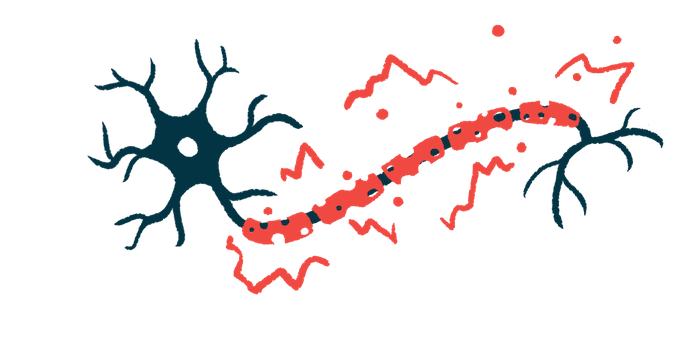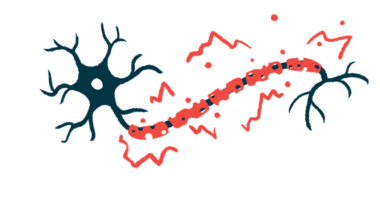More nerve damage in MS linked to increased microglia activation
Greater activation tied to higher levels of NfL protein in new study

Increased activation of microglia, the resident immune cells in the brain that contribute to chronic inflammation in multiple sclerosis (MS), is significantly associated with higher levels of neurofilament light chain (NfL) protein, indicating more nerve damage, a study found.
Researchers particularly identified strong links between activated microglia in chronic T1 hypointense lesions — areas of permanent nerve damage that show up on MRI scans as black holes — and in white matter found in deeper brain tissues, and NfL blood levels. NfL is a protein that serves as a biomarker for several neurodegenerative conditions, including MS.
Together, these findings show a “link between neuronal damage and microglial activation in MS,” the researchers wrote.
“Our results indicate that among patients with MS with no evidence of recent relapse activity or … lesions, increased NfL levels are an indication of an ongoing smouldering disease process,” the team wrote.
The study, “Association of serum neurofilament light with microglial activation in multiple sclerosis,” was published in the Journal of Neurology, Neurosurgery & Psychiatry.
Results show over 40% of patients had more microglia activation
MS is a neurodegenerative disease marked by the immune system erroneously attacking and damaging nerve cells, which can lead to a range of symptoms.
Previous studies have shown an association between microglia activation and nerve damage in multiple sclerosis, suggesting that microglia status could be “a significant predictor of MS disease progression,” the researchers wrote.
Microglial cells are often found on the edges of MS lesions — areas of abnormal tissue in the nervous system — that show chronic inflammation. There, they contribute to the ongoing inflammatory response and nerve damage that are the hallmarks of MS.
But these cells also are seen in other regions of the brain that are apparently undamaged.
Yet, whether the specific location of activated microglia has an impact on the extent of nerve damage remains to be examined.
To find out, a team of researchers based in Finland examined data from 44 MS patients and 24 healthy people. Their aim was to determine if the extent and location of microglia activation in the brain correlated with the amount of NfL found in the blood.
The patients in the study had a mean age of 46.5 and had been living with the disease for 13.3 years on average. Most had relapsing-remitting MS, and four had secondary progressive MS. The healthy people, who served as controls, were matched to patients in age and sex.
Microglial activation was detected using a radioactive tracer named [11C]PK11195. This tracer binds to a protein that is found inside activated microglial cells and can be visualized via positron emission tomography (PET) scans. The use of PET scans makes it possible to pinpoint their location and quantify immune cell activation inside the brain.
While both PET findings and NfL blood levels can help inform disease progression in brain diseases, “their potential association has not yet been studied in multiple sclerosis (MS) in vivo,” meaning in living organisms, the researchers wrote.
The results showed that overall microglia activation in the brain was greater in MS patients than in controls. Regions of normal-appearing white matter — myelin-laden regions that don’t seem to be damaged — also had more active microglia in the MS samples.
Among patients, 43% had increased microglia activation in the brain compared with controls; the remaining individuals had levels similar to those in the control group.
The group of patients with more active cells had a similar age and disease duration to those with less microglia activation. However, these patients had more disability and higher relapse rates. Those with more microglia activation in scans also had a higher number and volume of lesions with chronically active inflammation, as well as fewer inactive lesions.
Our results indicate that among patients with MS with no evidence of recent relapse activity or … lesions, increased NfL levels are an indication of an ongoing smouldering disease process.
No significant differences were seen in NfL levels between the two groups, but levels of this nerve damage marker correlated with greater (more extended) microglia activation in the group with higher activation.
In particular, higher NfL levels correlated with more microglia activation in overall normal-appearing white matter, in normal-appearing white matter close to MS lesions, and in the rim surrounding lesions. The same was found in chronic lesions.
NfL levels particularly correlated with the number and volume of lesions containing activated microglia, while no association was found for inactive lesions.
Overall, this study provides evidence that activated microglia in MS can “contribute to neuroaxonal [nerve fiber] damage resulting in release of neurofilament light (NfL),” the researchers wrote.
It also highlights the role of active brain lesions in promoting nerve damage and supports the “early use of highly efficacious therapy to achieve complete suppression of focal lesional disease activity,” the team concluded.







